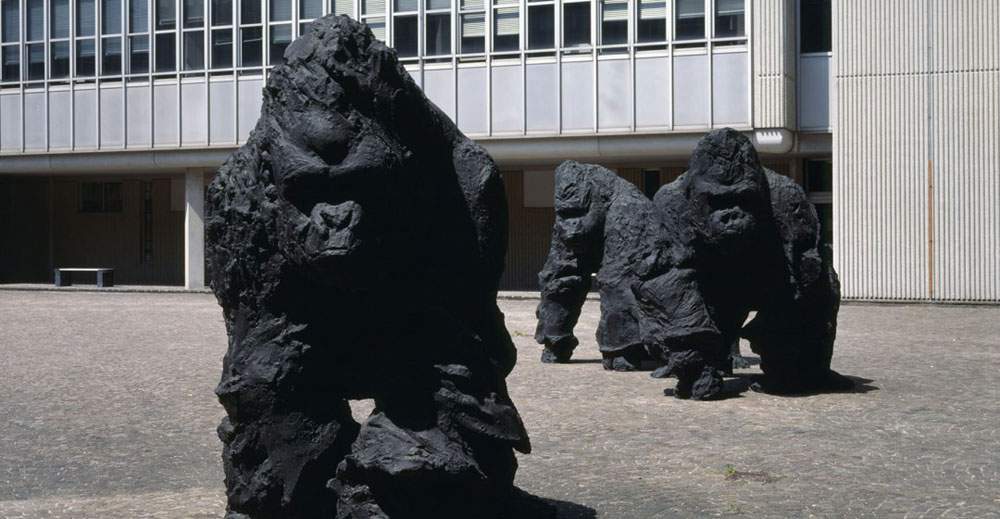Controversy has flared up in recent days over Davide Rivalta ’s large gorillas that have inhabited the inner cloister of the Ravenna Palace of Justice since 2002. Very realistic gorillas that seem to advance toward those who approach: placed in relation to the courthouse, an institution that represents the ethical dimension, the animals refer to the precultural condition of man.
The six bronze gorillas, each three meters tall, have been included in the cultural heritage of Emilia Romagna, and the artist’s goal was “to give form to the intense, sometimes even brutal, feelings that live in those who pass through a Tribunal,” as Claudia Collina stated in the volume that collects the artistic heritage surveyed. She adds, “The effectiveness of the work comes from the contrast between the austere linearity of the building and the primal energy of the sculptures. The dimensions, the attitudes, the nature of the animals portrayed, and of course the physical and visceral approach to the material all complete the balances of a symmetrical, linear and rigid architecture.”
Advancing the controversy is architect Angelo Barboni, on behalf of Lista Ravenna, who writes in a post, "It is undeniable to see in Davide Rivalta’s giant gorillas, placed to guard the Ravenna Court in its large open-air hall, remarkable artistic achievements. What is puzzling is the context. Surely, an Art Biennial, a parade ground or a park, where massive animals sculpted by the same Bologna artist are actually located, would have enhanced them properly. Instead, I find this location chilling, because of the place itself and the way these figures loom over those who, out of their own necessity or by call, present themselves at the entrance to the courthouse.“ He continues: ”I myself have seen little ones frightened and crying in their mother’s arms, walking quickly and with their heads down to dodge the menacing figures [...] And here, as the final touch to a nightmare, are the huge bronze gorillas by an Italian artist who is world-famous for rendering essence to the animals he reproduces life-size. Here, however, he has created them not so much imposing as menacing, an expression of brute force that crushes and annihilates the poor patron of human justice."
In Barboni’s opinion, Rivalta’s gorillas would be unsuitable for their current location and would frighten and make children cry, and more.
Responding to the architect’s polemics are curator and gallery owner Alessandra Carini and painter and tour guide Nicola Montalbini: "All too often it happens that public art is exploited for political purposes and cheap demagoguery is made [...] The sleep of reason breeds monsters, but the fog of the swamp is capable of far worse things! Fortunately, the 20th century has given us the greatest lesson in the history of art, namely that the value of a work is neither absolute nor traceable to a reassuring aesthetic form, but rather its decontextualization and the resulting disturbance plays a fundamental role in understanding the work itself. Therefore, no longer parlor art,“ they continue, ”but a black mirror reflecting the complexity of our time. The gorillas in question are, yes, out of context, but that is precisely why the work works, achieving the artist’s intent (“I wanted to give form to intense, sometimes brutal, feelings that live in those who go through a court of law).” As the Ravenna Prosecutor’s Office also explains well (“the effectiveness of the work is perceived between the immobile austerity proper to a Palace of Justice and the primordial energy of the sculptures”). The disturbance that springs from contemporary art once again shakes up rhetoric and respectability. The Tribunal, the gymnasium of modern rhetorical lawyers, thus becomes the arena of a primitive idea. A black patrol of ancient, ape-like silhouettes that only superficially embody menace and in truth are effigies of the most tame, communal and compassionate beasts on the planet. Older than us and so ominously similar as if to say “remember that’s where we came from.” We find it boorish and misplaced that works of art are mortified and continually exploited as election slogans; the compassionate mother who flees protecting her offspring from the shadow of the contemporary monster seems to be an easy bait for simplistic judgments made by people not knowledgeable about the subject. But in this time of dusty regurgitations,“ they conclude, ”political correctness returns to exhale its fetid breath: should we thus go back in time and once again adorn the Courthouses of Justice with colossal algid balance-holding ladies with an ancient flavor, decrepit and monolithic like the old age they carry?"
 |
| Ravenna, controversy over gorillas in Rivalta. "They scare children." |
Warning: the translation into English of the original Italian article was created using automatic tools. We undertake to review all articles, but we do not guarantee the total absence of inaccuracies in the translation due to the program. You can find the original by clicking on the ITA button. If you find any mistake,please contact us.